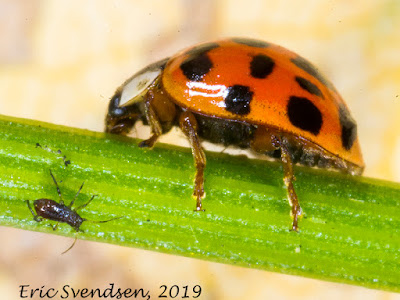Not a lady afterall.
 |
| Thirteen spotted ladybird beetle hunting for aphids. |
The story above is one of many possible explanations of how the ladybug obtained its moniker (reference: click here). Whether true or not, the title is ubiquitous and these beetles are found worldwide. In Canada alone, there are 150 species. Altogether there are about 5000 species.
Ladybirds, like all beetles, have complete metamorphosis. Their development goes from an egg to larva to pupa to adult. Bugs are a different group of insects that boast incomplete metamorphosis; the young look much like the adults without wings and they do not go through a pupa stage.
Both the larva and the adult have a voracious appetite and prey primarily on aphids. A single ladybird from hatchling to adult may eat an estimated 5000 aphids. Imagine the carnage that 100 of these pest-consuming invertebrates could impart on your garden. If they stuck around they could consume half a million of the little sap-sucking demons.
You can get them from some garden places locally in the spring, or even order them over the internet (here is an example: click here).
Thanks for reading. www.ericspix.com


So cute beetle https://www.saipixels.com/p/gallery.html
ReplyDelete